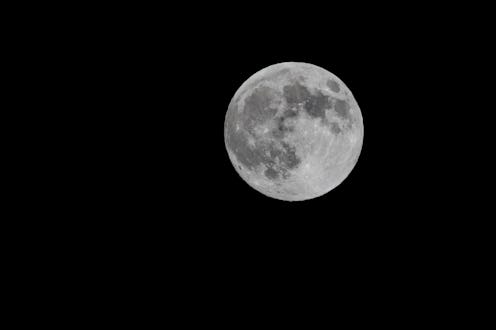Life
Here’s Why People Keep Calling The November Full Moon By Different Names

With Daylight Saving Time — and the schedule disruptions that come with it — looming large (ICYMI, we turn the clocks back by an hour on Nov. 5), I personally am finding distractions quite welcome. I'd rather not think about what it will feel like at 4 a.m. Monday when I can't fall back to sleep or about how it will feel to walk outside at 5 p.m. into total darkness, so I'm going to choose to think about other things instead: the sparkly shoes I want to buy for the holidays, the omelette that I'll probably order for brunch on Sunday, the Thanksgiving feast that's now only a few weeks away. For a slightly elevated distraction, though, we can all look to the sky this weekend instead, because Daylight Saving Time isn't the only event worth our attention. The full moon will be visible on Nov. 4 as well, and with all that talk of the Harvest Moon in October, I'm sure you're wondering what the November full moon is called. See? I've got you distracted already.
There are actually a few names for the November full moon, all of which have some serious history behind them. Depending on where you are and who you're talking to, you might hear this lunar event referred to as the Frost Moon, the Beaver Moon, or the Mourning Moon.
Native American tribes coined the Frost Moon nickname as a simple matter of timing. According to Almanac.com, the appearance of November's full moon was an important symbol of the coming winter for these communities, who took it as a hint that the first frost of the year was just around the corner. This gave them more time to prepare for the cold, snowy conditions to come — a fact that I can only image was highly appreciated in a world that lacked easy access to weather forecasts or smartphone apps that make it virtually impossible not to know what day or season it is.
The history of the Beaver Moon is closely related to that of the Frost Moon. Per Almanac.com, American colonists and Algonquin tribes relied on beaver fur for warmth in the long, cold winters. If they waited too long to set their traps, however, the water would freeze and they'd be out of luck. The November full moon was their reminder that the frost was ahead and that it was time to start collecting fur. While beavers are simply cute, buck-toothed dam builders to us in 2017, they were a really important part of the survival strategy for North Americans a few centuries ago, and the November full moon was key to making sure that the strategy was carried out successfully.
The Mourning Moon, on the other hand, is rooted in Pagan tradition. People who practice Pagan rituals spend the fall months preparing for the winter. The final step in that process is the letting go — and mourning — of old things that aren't expected to be helpful in the new year. Even those of us not familiar with Pagan tradition can appreciate this season as a time of reflection and letting go. Right before the chaos of the holidays sets in, we can take our cue from the Nov. 4 full moon and begin thinking back on 2017 and deciding which habits, goals, and people might best be left behind in the name of a happier 2018.
Whether you take the upcoming full moon — which should be brightest just after 1 a.m. EST on Nov. 4 — as your hint to break out the winter coats (the modern equivalent of beaver traps) or your inspiration for some serious end-of-year soul searching, you'll be totally in tune with our ancestors as you do it.
Images: Product of RDPhotography381/Moment/Getty Images; Giphy